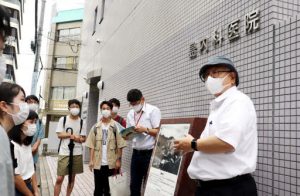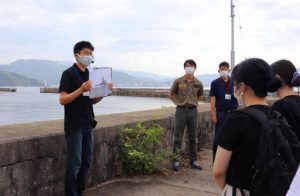Reflections on life at walking pace—Hiroshima University of Economics Professor Emeritus Okamoto gives final “Learn about Hiroshima” seminar
Sep. 20, 2021
Profound understanding of Hiroshima’s past as A-bombed city and military hub
by Rina Yuasa, Staff Writer
Sadao Okamoto, 69, professor emeritus at the Hiroshima University of Economics who led students over the years on educational visits to remnants of war-related facilities and former battlegrounds, held the final intensive seminar “Learn about Hiroshima,” during three days, August 23–25. Mr. Okamoto, who specializes in religious studies, will retire from teaching at the university, located in Hiroshima’s Asaminami Ward. What did Mr. Okamoto hope students would learn from walking around the city about the history of Hiroshima, a city that experienced the atomic bombing but also served as a military hub? Hoping to find out, this reporter joined the seminar by tagging along with a group of students.
The seminar fieldwork began with one minute of silent prayer offered by 13 students, along with Mr. Okamoto and Eiji Takebayashi, 55, an associate professor at the university, in front of the Atomic Bomb Dome in central Hiroshima. Before the Shima Internal Medicine Hospital, located at the hypocenter, Mr. Takebayashi said, “Now!” when the clock reached 8:15 a.m., prompting all the students to look up at the sky. When the bomb exploded 76 years ago around 600 meters aboveground, people might have looked up at the sky and been instantly incinerated. I suddenly felt weak in the knees.
At Hiroshima Castle, Mr. Takebayashi explained, “This is where the Imperial Japanese Army Headquarters were located. Emperor Meiji took command here during the Sino-Japanese War.” Only the foundation stones of the facility remain. “I jog around this area, but I didn’t know about the facility. The fact that a single bomb made it disappear as if it never existed…” said Haruka Shoji, 22, a senior at the university. While visiting the remnants of seven facilities, such as the 11th Infantry Regiment and the Hiroshima Army Cadet School, I realized what an enormous area those military facilities occupied.
On the last day of the seminar, we all paid a visit to Etajima City. In front of a monument located in the Konoura area in the town of Etajima-cho dedicated to a marine suicide attack unit, Kazumasa Okano, 67, who heads the group that maintains the monument, spoke to the students. “Young people just like you went through training here for suicide attack missions and later died at the front.” An old pier near the monument brought to my mind images of such young people.
The Nakamachi Military Cemetery, located in the town of Nomi-cho, contains about 180 graves, including those of soldiers who lost their lives in World War II. On each gravestone is inscribed someone’s age at death, such as “23” or “26.” Yu Sato, 20, a sophomore at Hiroshima City University, said, “I imagined how each lived his or her life. War is cruel and sad.” On the same day, students visited the remnants of military facilities in Kure City, following which the special seminar’s itinerary concluded.
Mr. Okamoto organized intensive seminars annually for 14 years as part of a credit transfer system among a widespread network of schools managed by the organization called the Education Network in the Chugoku Area, in which Hiroshima is located. The largest number of students for the seminar was about 80. Before the coronavirus pandemic, the participants would walk the roughly eight kilometers from the hypocenter to Hiroshima Castle and on to Hiroshima Port, which is located in the city’s Minami Ward. The intent of that plan was to follow the path victims took in their attempt to flee to safety after the atomic bombing.
During a period of 14 years, Mr. Okamoto would take his seminar students to Okinawa. They would walk 50 kilometers between Naha City and Itoman City, visiting remnants of moats and other sites related to the Battle of Okinawa and listening to stories about the battle told by survivors.
“I hope you reflect on peoples’ lives at a walking pace. You will gain a profound understanding different from what you learn in lecture halls.” According to Mr. Okamoto, even if some students were reluctant at first, by the last day of the seminar, they had clearly different facial expressions after the experience. Some students wrote in their reports after the end of the program that they wanted the seminar to continue to be held into the future. It is my true hope that Mr. Okamoto’s ideas can continue to be passed on in some way in the future.
(Originally published on September 20, 2021)









